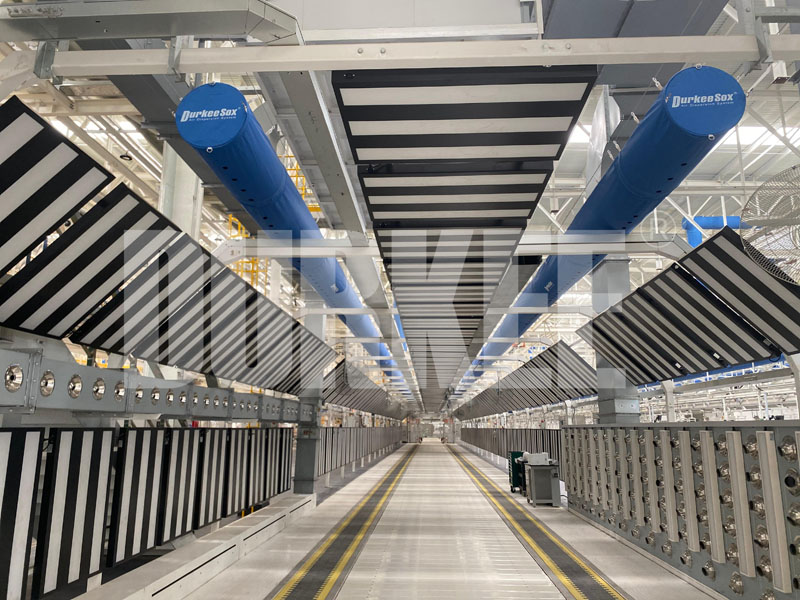 How Durkee Smart HVAC Innovations Take Center Stage at China Refrigeration 2025
How Durkee Smart HVAC Innovations Take Center Stage at China Refrigeration 2025
 Advantages and Prospects of Cloth Air Ducts
Advantages and Prospects of Cloth Air Ducts
 Fabric Duct: Innovator of Flexible Ventilation Systems
Fabric Duct: Innovator of Flexible Ventilation Systems
Ventilation ductwork is an essential part of modern building design, playing a pivotal role in ensuring indoor air quality and comfort. Comprised of a network of ducts, this system efficiently transports air from heating, ventilation, and air-conditioning (HVAC) systems throughout a facility. Whether in public facilities, commercial spaces, or industrial setups, proper ventilation ductwork helps maintain a healthy, comfortable, and energy-efficient environment.

The primary purpose of a flexible fabric duct is to manage and distribute air within a facility. There are several key functions that these systems serve:
1. Air Distribution: Ventilation ducts distribute conditioned air (heated, cooled, or filtered) from the HVAC system to different areas within a facility. This ensures a consistent and comfortable climate.
2. Air Quality: Ventilation ducts play a crucial role in maintaining indoor air quality by removing stale air and bringing in fresh air from outside. This is particularly important in buildings with limited natural ventilation.
3. Humidity Control: Proper ventilation helps control humidity levels, reducing the risk of mold growth and other moisture-related problems.
4. Energy Efficiency: By efficiently distributing air, ventilation ducts help HVAC systems operate more effectively, potentially lowering energy costs.
5. Comfort: Well-designed ductwork helps eliminate hot or cold spots within a building, providing consistent comfort throughout.
Ventilation ducting comes in various types, each suited for specific applications. Understanding these different types can help in choosing the right ductwork for your applications.
1. Sheet Metal Ducts: Made from galvanized steel or aluminum, these ducts are durable, long-lasting, and commonly used in commercial and industrial settings.
2. Flexible Ducts: Often made from plastic and wire, flexible ducts are easier to install and are commonly used in residential settings. However, they are less durable than sheet metal ducts.
3. Fiberglass Ducts: These ducts are lined with fiberglass to provide thermal insulation and sound absorption. They are ideal for applications where noise control is a priority.
4. Fabric Ducts: Made from special fabric, these ducts are lightweight and easy to install. They are commonly used in large open spaces like gyms and warehouses, or workstation. Fabric ducts can also support uniform air distribution at specific workstations, ensuring even airflow, They are known for their energy efficiency, low air leakage, and ease of maintenance
5. Non-Rigid Air Ducts: These include fabric ducts and composite ductwork. Composite ductwork, such as Durkduct’s Insusox Pre-insulated Air Duct, integrates special textile duct surfaces with high-performance thermal insulation using patented composite technology. This type of ductwork is lightweight, easy to install, and offers superior thermal insulation performance. It is suitable for a wide range of applications, including industrial facilities, logistics warehouses, and commercial buildings
Each type of ventilation duct has its own set of advantages and is suitable for different applications. The choice depends on factors like facility type, budget, and specific needs.
While the terms "duct" and "vent" are often used interchangeably, they refer to different components of an HVAC sock duct systems.
- Duct: A duct is a conduit or passage used for the transportation of air. It forms part of the ductwork system that moves air throughout a facility, connecting the HVAC system to various facilities and areas.
- Vent: A vent is an opening that allows air to enter or exit the ductwork system. Vents can be found at the end of ducts, where air is released into a facility, or at the beginning, where air is drawn into the system.
Understanding the distinction between ducts and vents is crucial for proper HVAC system design and maintenance. Ducts are responsible for the transportation of air, while vents regulate the flow of air into and out of the ductwork system.
In conclusion, ventilation ductwork is a vital component of any facility's HVAC system. Its main purposes are air distribution, air quality maintenance, humidity control, energy efficiency, and overall comfort. Various types of hvac duct sock, including sheet metal ducts, flexible ducts, fiberglass ducts, fabric ducts, and PVC ducts, cater to different needs and applications. Additionally, it's important to differentiate between ducts, which transport air, and vents, which allow air to enter or exit the ductwork system.
By understanding the intricacies of ventilation ductwork, you can make informed decisions that lead to healthier, more comfortable, and energy-efficient indoor environments. For high-quality ventilation duct solutions, consider trusted brands like Durkduct, known for their reliable and efficient products in the HVAC industry. Whether you're planning a new installation or upgrading an existing system, make sure to choose the right ductwork to suit your specific needs.